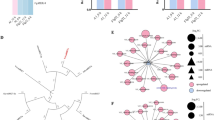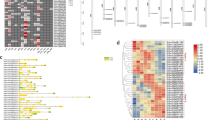Abstract
Key message
CpERF9 controls papaya fruit ripening through transcriptional repression of cell-wall-modifying genes CpPME1/2 and CpPG5 by directly binding to their promoters.
Abstract
Papaya fruit ripening is an intricate and highly coordinated developmental process which is controlled by the action of ethylene and expression of numerous ethylene-responsive genes. Ethylene response factors (ERFs) representing the last regulators of ethylene-signaling pathway determine the specificities of ethylene response. However, knowledge concerning the transcriptional controlling mechanism of ERF-mediated papaya fruit ripening is limited. In the present work, a gene-encoding AP2/ERF protein with two ERF-associated amphiphilic repression (EAR) motifs, named CpERF9, was characterized from papaya fruit. CpERF9 was found to localize in nucleus, and possess transcriptional repression ability. CpERF9 expression steadily decreased during papaya fruit ripening, while several genes encoding pectin methylesterases (PMEs) and polygalacturonases (PGs), such as CpPME1/2 and CpPG5, were gradually increased, paralleling the decline of fruit firmness. Electrophoretic mobility shift assay (EMSA) demonstrated a specific binding of CpERF9 to promoters of CpPME1/2 and CpPG5, via the GCC-box motif. Transient expression of CpERF9 in tobacco repressed CpPME1/2 and CpPG5 promoter activities, which was depended on two EAR motifs of CpERF9 protein. Taken together, these findings suggest that papaya CpERF9 may act as a transcriptional repressor of several cell-wall modifying genes, such as CpPME1/2 and CpPG5, via directly binding to their promoters.








Similar content being viewed by others
Abbreviations
- EAR:
-
ERF-associated amphiphilic repression
- EMSA:
-
Electrophoretic mobility shift assay
- ERF:
-
Ethylene response factor
- GFP:
-
Green fluorescence protein
- PG:
-
Polygalacturonase
- PME:
-
Pectin methylesterase
- RT-qPCR:
-
Real-time quantitative polymerase chain reaction
- TF:
-
Transcription factor
References
Asif MH, Nath P (2005) Expression of multiple forms of polygalacturonase gene during ripening in banana fruit. Plant Physiol Biochem 43:177–184
Ba LJ, Shan W, Kuang JF, Feng BH, Xiao YY, Lu WJ, Chen JY (2014a) The banana MaLBD (lateral organ boundaries domain) transcription factors regulate EXPANSIN expression and are involved in fruit ripening. Plant Mol Biol Rep 32:1103–1113
Ba LJ, Shan W, Xiao YY, Chen JY, Lu WJ, Kuang JF (2014b) A ripening-induced transcription factor MaBSD1 interacts with promoters of MaEXP1/2 from banana fruit. Plant Cell Rep 33:1913–1920
Catinot J, Huang JB, Huang PY, Tseng MY, Chen YL, Gu SY, Lo WS, Wang LC, Chen YR, Zimmerli L (2015) ETHYLENE RESPONSE FACTOR96 positively regulates Arabidopsis resistance to necrotrophic pathogens by direct binding to GCC elements of jasmonate- and ethylene-responsive defence genes. Plant, Cell Environ 38:2217–2734
De Oliveira JG, Vitória PA (2011) Papaya: nutritional and pharmacological characterization, and quality loss due to physiological disorders. An overview. Food Res Int 44:1306–1313
El-Sharkawy I, Sherif S, Mila I, Bouzayen M, Jayasankar S (2009) Molecular characterization of seven genes encoding ethylene-responsive transcriptional factors during plum fruit development and ripening. J Exp Bot 3:907–922
Fabi JP, Broetto SG, da Silva SLGL, Zhong S, Lajolo FM, do Nascimento JRO (2014) Analysis of papaya cell wall-related genes during fruit ripening indicates a central role of polygalacturonases during pulp softening. PLoS One 9:e105685
Fan ZQ, Kuang JF, Fu CC, Shan W, Han YC, Xiao YY, Ye YJ, Lu WJ, Lakshmanan P, Duan XW, Chen JY (2016) The banana transcriptional repressor MaDEAR1 negatively regulates cell wall-modifying genes involved in fruit ripening. Front Plant Sci 7:1021
Fu CC, Han YC, Fan ZQ, Chen JY, Chen WX, Lu WJ, Kuang JF (2016) The papaya transcription factor CpNAC1 modulates carotenoid biosynthesis through activating phytoene desaturase genes CpPDS2/4 during fruit ripening. J Agric Food Chem. doi:10.1021/acs.jafc.6b01020
Fujimoto SY, Ohta M, Usui A, Shinshi H, Ohme-Takagi M (2000) Arabidopsis ethylene-responsive element binding factors act as transcriptional activators or repressors of GCC box–mediated gene expression. Plant Cell 12:393–404
Fujisawa M, Nakano T, Ito Y (2011) Identification of potential target genes for the tomato fruit-ripening regulator RIN by chromatin immunoprecipitation. BMC Plant Biol 11:26
Han YC, Kuang JF, Chen JY, Liu XC, Xiao YY, Fu CC, Wang JN, Wu KQ, Lu WJ (2016) Banana transcription factor MaERF11 recruits histone deacetylase MaHDA1 and represses the expression of MaACO1 and Expansins during fruit ripening. Plant Physiol 171:1070–1084
Hao DY, Ohme-Takagi M, Sarai A (1998) Unique mode of GCC box recognition by the DNA-binding domain of ethylene-responsive element-binding factor (ERF domain) in plant. J Biol Chem 273:26857–26861
Hellens RP, Allan AC, Friel EN, Bolitho K, Grafton K, Templeton MD, Karunairetnam S, Gleave AP, Laing WA (2005) Transient expression vectors for functional genomics, quantification of promoter activity and RNA silencing in plants. Plant Methods 1:13
Irfan M, Ghosh S, Meli VS, Kumar A, Kumar V, Chakraborty N, Chakraborty S, Datta A (2016) Fruit ripening regulation of α-Mannosidase expression by the mads box transcription factor RIPENING INHIBITOR and ethylene. Front Plant Sci 7:10
Kagale S, Rozwadowski K (2011) EAR motif-mediated transcriptional repression in plants: an underlying mechanism for epigenetic regulation of gene expression. Epigenetics 6:141–146
Kagale S, Links MG, Rozwadowski K (2010) Genome-wide analysis of ethylene-responsive element binding factor-associated amphiphilic repression motif-containing transcriptional regulators in Arabidopsis. Plant Physiol 152:1109–1134
Klee HJ, Giovannoni JJ (2011) Genetics and control of tomato fruit ripening and quality attributes. Annu Rev Genet 45:41–59
Kuang JF, Chen JY, Luo M, Wu KQ, Sun W, Jiang YM, Lu WJ (2012) Histone deacetylase HD2 interacts with ERF1 and is involved in longan fruit senescence. J Exp Bot 63:441–454
Lee SY, Hwang EY, Seok HY, Tarte VN, Jeong MS, Jang SB, Moon YH (2015) Arabidopsis AtERF71/HRE2 functions as transcriptional activator via cis-acting GCC box or DRE/CRT element and is involved in root development through regulation of root cell expansion. Plant Cell Rep 34:223–231
Lee MS, An JH, Cho HT (2016) Biological and molecular functions of two EAR motifs of Arabidopsis IAA7. J Plant Biol 59:24–32
Li XP, Zhu XY, Mao J, Zou Y, Fu DW, Chen WX, Lu WJ (2013) Isolation and characterization of ethylene response factor family genes during development, ethylene regulation and stress treatments in papaya fruit. Plant Physiol Biochem 70:81–92
Liang HX, Lu Y, Liu HX, Wang FD, Xin ZY, Zhang ZY (2008) A novel activator-type ERF of Thinopyrum intermedium, TiERF1, positively regulates defence responses. J Exp Bot 59:3111–3120
Liu M, Pirrello J, Chervin C, Roustan JP, Bouzayen M (2015) Ethylene control of fruit ripening: revisiting the complex network of transcriptional regulation. Plant Physiol 169:2380–2390
Livak KJ, Schmittgen TD (2001) Analysis of relative gene expression data using real-time quantitative PCR and the 2− ΔΔCT method. Methods 25:402–408
McGrath KC, Dombrecht B, Manners JM, Schenk PM, Edgar CI, Maclean DJ (2005) Repressor-and activator-type ethylene response factors functioning in jasmonate signaling and disease resistance identified via a genome-wide screen of Arabidopsis transcription factor gene expression. Plant Physiol 139:949–959
Ohme-Takagi M, Shinshi H (1995) Ethylene-inducible DNA binding proteins that interact with an ethylene-responsive element. Plant Cell 7:173–182
Ohta M, Matsui K, Hiratsu K, Shinshi H, Ohme-Takagi M (2001) Repression domains of class II ERF transcriptional repressors share an essential motif for active repression. Plant Cell 13:1959–1968
Paull RE, Nishijima W, Reyes M, Cavaletto C (1997) Postharvest handling and losses during marketing of papaya (Carica papaya L.). Postharvest Biol Technol 11:165–179
Sainsbury F, Thuenemann EC, Lomonossoff GP (2009) pEAQ: versatile expression vectors for easy and quick transient expression of heterologous proteins in plants. Plant Biotechnol J 7:682–693
Shan W, Kuang JF, Chen L, Xie H, Peng HH, Xiao YY, Li XP, Chen WX, He QG, Chen JY, Lu WJ (2012) Molecular characterization of banana NAC transcription factors and their interactions with ethylene signalling component EIL during fruit ripening. J Exp Bot 63:5171–5187
Shiga TM, Fabi JP, do Nascimento JRO, de Oliveira Petkowicz CL, Vriesmann LC, Lajolo FM, Cordenunsi BR (2009) Changes in cell wall composition associated to the softening of ripening papaya: evidence of extensive solubilization of large molecular mass galactouronides. J Agric Food Chem 57:7064–7071
Shyu C, Figueroa P, DePew CL, Cooke TF, Sheard LB, Moreno JE, Katsir L, Zheng N, Browse J, Howe GA (2012) JAZ8 lacks a canonical degron and has an EAR motif that mediates transcriptional repression of jasmonate responses in Arabidopsis. Plant Cell 24:536–550
Song CP, Agarwal M, Ohta M, Guo Y, Halfter U, Wang PC, Zhu JK (2005) Role of an Arabidopsis AP2/EREBP-type transcriptional repressor in abscisic acid and drought stress responses. Plant Cell 17:2384–2396
Song LY, Wang ZG, Wang ZM, Meng G, Zhai R, Cai M, Ma FW, Xu LF (2016) Screening of cell wall-related genes that are expressed differentially during ripening of pears with different softening characteristics. Postharvest Biol Technol 115:1–8
Tournier B, Sanchez-Ballesta MT, Jones B, Pesquet E, Regad F, Latché A, Pech JC, Bouzayen M (2003) New members of the tomato ERF family show specific expression pattern and diverse DNA-binding capacity to the GCC box element. FEBS Lett 550:149–154
Vallejo-Reyna MA, Santamaría JM, Rodríguez-Zapata LC, Herrera-Valencia VA, Peraza-Echeverria S (2015) Identification of novel ERF transcription factor genes in papaya and analysis of their expression in different tissues and in response to the plant defense inducer benzothiadiazole (BTH). Physiol Mol Plant Pathol 91:141–151
Vasu P, Savary BJ, Cameron RG (2012) Purification and characterization of a papaya (Carica papaya L.) pectin methylesterase isolated from a commercial papain preparation. Food Chem 133:366–372
Villarreal NM, Rosli HG, Martínez GA, Civello PM (2008) Polygalacturonase activity and expression of related genes during ripening of strawberry cultivars with contrasting fruit firmness. Postharvest Biol Technol 47:141–150
Wan CY, Wilkins TA (1994) A modified hot borate method significantly enhances the yield of high-quality RNA from cotton (Gossypium hirsutum L.). Anal Biochem 223:7–12
Xiao YY, Chen JY, Kuang JF, Shan W, Xie H, Jiang YM, Lu WJ (2013) Banana ethylene response factors are involved in fruit ripening through their interactions with ethylene biosynthesis genes. J Exp Bot 64:2499–2510
Yang Z, Tian LN, Latoszek-Green M, Brown D, Wu KQ (2005) Arabidopsis ERF4 is a transcriptional repressor capable of modulating ethylene and abscisic acid responses. Plant Mol Biol 58:585–596
Yin XR, Allan AC, Chen KS, Ferguson IB (2010) Kiwifruit EIL and ERF genes involved in regulating fruit ripening. Plant Physiol 153:1280–1292
Yu ZX, Li JX, Yang CQ, Hu WL, Wang LJ, Chen XY (2012) The jasmonate-responsive AP2/ERF transcription factors AaERF1 and AaERF2 positively regulate artemisinin biosynthesis in Artemisia annua L. Mol Plant 5:353–365
Zeng JK, Li X, Xu Q, Chen JY, Yin XR, Ferguson IB, Chen KS (2015) EjAP2-1, an AP2/ERF gene, is a novel regulator of fruit lignification induced by chilling injury, via interaction with EjMYB transcription factors. Plant Biotechnol J 13:1325–1334
Zhang HW, Zhang JF, Quan RD, Pan XW, Wan LY, Huang RF (2013) EAR motif mutation of rice OsERF3 alters the regulation of ethylene biosynthesis and drought tolerance. Planta 237:1443–1451
Zhu XY, Li XP, Chen WX, Chen JY, Lu WJ, Chen L, Fu DW (2012) Evaluation of new reference genes in papaya for accurate transcript normalization under different experimental conditions. PLoS One 7:e44405
Acknowledgments
The authors would like to thank Professor Junping Gao (Department of Ornamental Horticulture, China Agricultural University), Professor Shouyi Chen (Institute of Genetics and Developmental Biology, Chinese Academy of Sciences), and Professor George P. Lomonossoff (Department of Biological Chemistry, John Innes Centre, Norwich Research Park) for the generous gifts of the transient expression vectors and pEAQ vectors, respectively. Comments and suggestion from Dr. Prakash Lakshmanan during revision is gratefully acknowledged. This work was supported by the National Key Research and Development Program (No. 2016YFD0400103), National Science and Technology Pillar Program during the Twelfth Five-Year Plan Period of China (No. 2011BAD24B02-4).
Author information
Authors and Affiliations
Corresponding author
Ethics declarations
Conflict of interest
The authors declare that they have no conflicts of interest.
Additional information
Communicated by P. Lakshmanan.
Electronic supplementary material
Below is the link to the electronic supplementary material.
Rights and permissions
About this article
Cite this article
Fu, CC., Han, YC., Qi, XY. et al. Papaya CpERF9 acts as a transcriptional repressor of cell-wall-modifying genes CpPME1/2 and CpPG5 involved in fruit ripening. Plant Cell Rep 35, 2341–2352 (2016). https://doi.org/10.1007/s00299-016-2038-3
Received:
Accepted:
Published:
Issue Date:
DOI: https://doi.org/10.1007/s00299-016-2038-3




